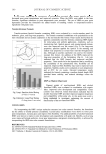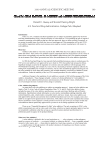ALTERNATIVES TO COSMETICS PRESERVATION 119 Anticellulite cream Cleansing milk Peeling cream Microbiological analysis Microbiological analysis Microbiological analysis TAPC* Ident. TAPC* Ident. TAPC* Ident. (cfu/g) Micr. (cfu/g) Micr. (cfu/g) Micr. No.1 No.2 No.3 MV# No.1 No.2 No.3 MV# No.1 No.2 No.3 MV# 10 10 10 10 Abs. 10 10 10 10 Abs. 10 10 10 10 Abs. 10 10 10 10 Abs. 10 10 10 10 Abs. 10 10 10 10 Abs. 10 10 10 10 Abs. 10 10 10 10 Abs. 10 10 10 10 Abs. 10 10 10 10 Abs. yeast in the O/W formulations tested. Systems VII and VIII with (0.3% w/w) levulinic acid and (0.1% w/w) p-anisic acid, respectively, preserved suffi ciently the emulsifi ed products and criterion A was fulfi lled. No contamination from the mold was detected either in the intact product or during the in-use consumer study. (Tables V, VII, and VIII). Anticellulite cream Cleansing milk Peeling cream Microbiological analysis Microbiological analysis Microbiological analysis TAPC* Ident. TAPC* Ident. TAPC* Ident. (cfu/g) Micr. (cfu/g) Micr. (cfu/g) Micr. No.1 No.2 No.3 MV# No.1 No.2 No.3 MV# No.1 No.2 No.3 MV# 7300 9500 10200 9000 A. niger 8500 8500 9400 8800 A. niger 9200 9600 9700 9500 A. niger 10 10 10 10 Abs. 10 10 10 10 Abs. 10 10 10 10 Abs. 10 10 10 10 Abs. 10 10 10 10 Abs. 10 10 10 10 Abs. 10 10 10 10 Abs. NA NA NA NA NA Table VII (cont’d) Table VIII (cont’d)
JOURNAL OF COSMETIC SCIENCE 120 PHYSICOCHEMICAL STABILITY The results concerning physicochemical stability are summarized in Table IV. Lonicera extracts alone (system I) was used only in the case of the tonic lotion and did not cause stability problems. The addition of (0.1% w/w) p-anisic acid or (0.3% w/w) levulinic acid to system I (i.e, systems II and III), caused the precipitation of solids after a few days. System V afforded stable O/W emulsions, the shampoo and the shower gel. However, it could not be used in the case of the tonic lotion, where the water content was high, due Figure 1. Challenge tests (E. Ph.) in various cosmetic forms containing prservative system V: (a) S. aureus, (b) P. aeruginosa, (c) E. coli, (d) A. niger, and (e) C. albicans.
Purchased for the exclusive use of nofirst nolast (unknown) From: SCC Media Library & Resource Center (library.scconline.org)





































































































































